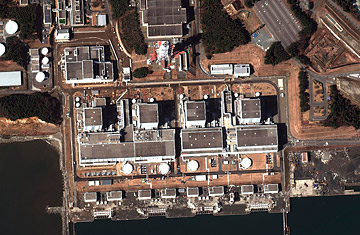
A satellite image shows earthquake and tsunami damage at the Fukushima Daini nuclear plant in Japan on March 12, 2011
The one quick solution to the crisis at the Fukushima nuclear power facility is to restore power to it. There is an irony to that observation: a nuclear power plant in need of power. But the problem at Unit 1 at Fukushima Daiichi began with a double whammy: the 8.9-magnitude earthquake off the coast of Japan that apparently knocked out its main source of electrical power and the resulting tsunami that put the facility's backup power supply out of commission. The improbable one-two punch resulted in what is called a "station blackout," according to Kenneth Bergeron, a physicist who used to work on nuclear-reactor-accident simulation at Sandia National Laboratories in the U.S. The likelihood of the scenario was so low that few statisticians expected it ever to happen. But it has in Fukushima.
The lack of power meant that Unit 1 could not pump enough water to cool the uranium fuel rods at the heart of the reactor — hence the decision early Sunday morning to flood it with nearby and plentiful seawater in a last-ditch attempt to avert a catastrophic meltdown, a tactic one expert called "a Hail Mary pass." What is key is either rebooting Fukushima's electrical generators (both AC and diesel) or shipping in units powerful enough to pump coolant into the reactor at a sufficient rate and volume to bring the heat down.
Otherwise, the plant will have to depend on good timing and a lot of luck. The timing depends on how fast the fuel rods lose heat. After the quake, the reactor had shut down and so the fuel rods had already begun their cooldown. That cooling starts from the equivalent of 50 megawatts of power, an enormous amount of heat — but the uranium rods lose heat at a curve, so, Bergeron estimates, a few days of stopgap measures may be all that's required to keep something catastrophic from happening.
The trouble with that scenario is that it all depends on intervening events. The reported presence of cesium 127 was disturbing because the element is usually evidence that the reactor core has overheated, if only for a portion of time. The radioactive debris is produced when the core is exposed above the coolant-water level and then overheats. All it takes is 20 to 50 minutes of exposure to produce enough heat to let off cesium 127. One of the other potential by-products of such overheating is hydrogen, which is produced when the zirconium sheaths around the uranium rods form a chemical reaction with the heat and steam. Hydrogen is believed to be the cause of the explosion at Fukushima on Saturday, which was captured on videotape and alarmed not only Japan but also most of the watching world.
What happens next depends on whether enough coolant is reintroduced or whether the uranium rods are cooling fast enough on their own to avoid a meltdown. It also depends on how old the fuel rods are: fresher rods cool down faster, older ones take much longer. The trouble in this regard is that Fukushima's reactors are of a decades-old design, and Unit 1 was reportedly scheduled to be retired later this month.
If the rods remain hot enough and exposed above the necessary level of cooling water, they will start to melt. If this condition — called slumping — is unarrested, the material will eventually puddle on the containment floor and probably eat away at it, eventually becoming exposed to the external environment. There is still a possibility of introducing enough coolant before that happens to impede damage, but because the geometry of the rods — their very shape — is lost through melting, water's ability to wrap around and cool the radioactive material is greatly diminished. What you have is a large amount of liquid sitting above the deadly sludge but not completely enveloping it, so it continues to eat away at the bottom.
All of this can happen in a matter of days. At Fukushima — and throughout Japan, as rescuers search for survivors of the earthquake and tsunami — time is of the essence.
